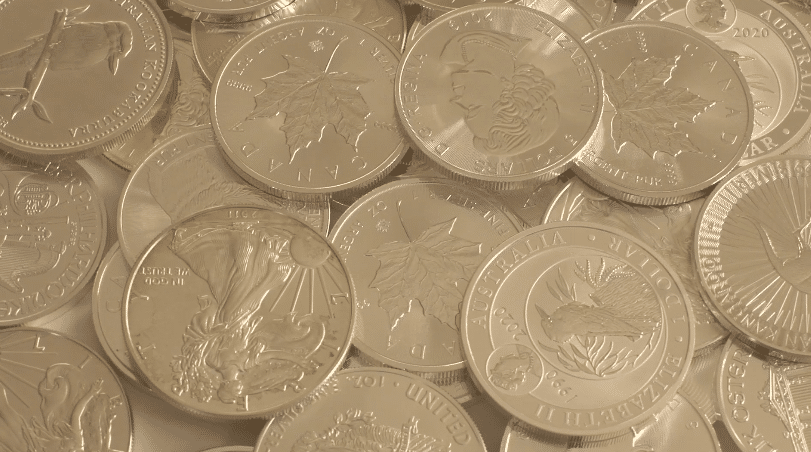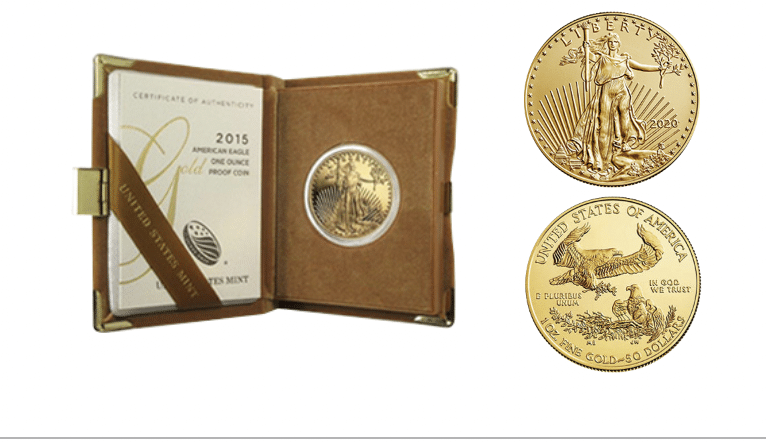What Is the Difference Between Proof and Bullion Coins?

When you’re exploring the difference between proof and bullion coins, you’re delving into a fascinating aspect of numismatics that reflects a blend of artistry, craftsmanship, and investment savvy.
Regarding differences, bullion coins are churned out in large quantities to meet investors’ demands, focusing on the purity and weight of the metal, making them a cornerstone for those looking to preserve wealth and diversify their portfolios with tangible assets. On the flip side, proof coins are the pinnacle of minting artistry, produced in limited numbers through a meticulous process that gives them a mirror-like finish and intricate designs, which captivate collectors and add a layer of scarcity and potential value appreciation. Their craftsmanship and rarity often command a premium, resonating deeply with enthusiasts who cherish both beauty and the stories coins carry.
As you embark on this journey, you’ll uncover layers of passion, investment strategies, and historical richness that lie beyond the surface.
Production Process Overview
Diving into the production process, bullion coins are struck in vast quantities using traditional methods, focusing on efficiency to meet the high demand of investors and collectors alike. You’ll find that the heart of creating these investment pieces lies in their mass production capabilities. Mints across the globe have honed the art of striking bullion coins, ensuring each piece contains the precise amount of precious metal, as advertised. This precision isn’t just about meeting standards; it’s a promise of value, a testament to the mint’s reputation.
When you delve deeper, you’ll discover that the production of bullion coins is a marvel of modern minting technology combined with centuries-old techniques. The blanks, prepared beforehand, are fed into presses. These machines exert immense pressure, imprinting the designs onto the metal with a single, efficient strike. This process isn’t just about speed; it’s about consistency. Each coin needs to be nearly identical, minimizing variations to ensure that when you’re holding a bullion coin, you’re holding an asset recognized and valued worldwide.
The pricing of these coins includes not just the value of the metal but also the costs of this finely tuned process. From the minting cost to distribution expenses and a margin for the dealer, every step in the journey from raw metal to finished coin adds a little to the premium you pay over the spot price. Yet, this premium is a small price for the assurance of quality and the ease with which these coins can be traded, making them an indispensable part of any precious metal investment strategy.

Design and Finish Distinctions
Exploring the design and finish distinctions between bullion and proof coins reveals a world where artistry meets precision, significantly impacting their value and appeal. When you delve into bullion coins, you’re engaging with pieces designed for efficiency and mass production. Their straightforward designs and standard finishes are a testament to their primary role in the precious metals market as a solid, tangible investment. Yet, it’s the simplicity of bullion coins that underlines their reliability and utility in diversifying portfolios.
On the flip side, proof coins stand as the pinnacle of minting craftsmanship. Each proof coin is a masterpiece, showcasing intricate designs that demand a closer look. The production process for these coins is labor-intensive, involving multiple strikes with specially prepared dies to create a stunning, mirror-like finish that highlights every detail. This level of detail and the sheer effort put into each coin don’t just add to its aesthetic appeal; they imbue proof coins with a sense of rarity and exclusivity.
While minor imperfections from the striking process might mar the surface of bullion coins, such flaws are virtually nonexistent in proof coins. This perfection is not by chance but a result of meticulous attention to detail throughout their creation. The contrast in design and finish between bullion and proof coins isn’t just about looks; it’s a reflection of their distinct roles in the world of coin collecting and investment. Proof coins, with their beauty and precision, beckon collectors and connoisseurs, offering not just a piece of precious metal but a work of art.
Pricing Differences
When considering the acquisition of precious metals, it’s crucial to understand that the pricing differences between bullion and proof coins stem from their distinct production processes and intended markets. You’re not just buying a piece of metal; you’re investing in craftsmanship, the art of minting, and a piece of history.
Bullion coins, the bedrock of precious metal portfolios, are minted in large quantities with a focus on efficiency. Their value is primarily tied to the current metal spot prices, plus a premium. This premium covers the costs of minting, distribution, and dealer profit, but it’s kept as low as possible to make these coins an accessible investment. They’re your entry into the tangible world of precious metal investing, offering a straightforward, cost-effective way to diversify your portfolio.
On the other hand, proof coins are crafted for connoisseurs. Each coin undergoes a meticulous, labor-intensive production process, resulting in intricate designs and a flawless finish that reflects the pinnacle of minting craftsmanship. This high level of artistry and the additional steps in the production process drive up the cost, making proof coins more expensive than their bullion counterparts. The pricing of proof coins not only reflects the precious metal content but also pays homage to the exceptional skill and time invested in each coin.
Understanding these pricing differences is pivotal. Bullion coins offer a direct, budget-friendly path to precious metal investment, while proof coins cater to those who value artistry and limited production runs. It’s not just about the metal; it’s about what that metal represents.
Gold is valuable and can be expensive. Owning physical gold and precious metals requires responsible sourcing of grades, purity, condition, best prices, and most of all, security and storage. A long-established and trusted gold IRA company that can provide competitive prices, price transparency, reliable customer service, and security of your precious metals.
Depending on whether you are a high-net investor looking for the most competitive prices or require a lower investment minimum and affordable entry to the gold market, we have researched and reviewed our best 4 gold IRA and precious metal investment companies that meet those individual needs. Whether you prefer a gold IRA or owning the physical gold at your place of residence.
To learn more about the advantages of tax-deferred gold IRAs right now, click the banner below to access and download Augusta Precious Metals’ free gold IRA checklist to make sure you are aware of all aspects of the gold IRA process:
Collectability and Rarity
Despite the increasing demand for gold, gold miners can’t simply ramp up their production to meet this need. This might seem counterintuitive given the market forces of supply and demand. However, it’s not as simple as flipping a switch. Gold mining is a complex process, requiring significant capital investment, sophisticated equipment, and a skilled workforce.
Furthermore, the locations where gold can be mined are finite. Geological challenges and environmental concerns also limit where and how much gold can be extracted. Securing the necessary permits and approvals for new mining projects is a time-consuming and often unpredictable process.
The 2008 credit crunch severely impacted gold producers’ ability to secure financing for new projects. This financial instability hindered their ability to increase production to meet the growing demand. Even as the global economy has recovered, the effects linger, causing a lag in the gold mining industry’s capacity to expand.
This inability to boost gold production has implications for you as an investor. The limited supply of gold, coupled with its growing demand, underpins its value. Simply put, the less there’s of something everyone wants, the more valuable it becomes.
Investment Considerations
Investors must carefully weigh the potential rewards and risks associated with choosing between bullion and proof coins for their portfolios. It’s a decision that doesn’t just reflect your investment strategy but also reveals your passion for the art and history encapsulated within each coin.
If you’re drawn towards bullion coins, you’re embracing a straightforward, cost-effective path to diversifying your investment with precious metals. These coins, like the revered Gold American Eagles and Silver American Eagles, are your bedrock. Their value closely follows the metal spot prices, offering a transparent, liquid asset that’s easy to trade. You’re investing in the tangible weight of precious metals, hedging against inflation with assets that have stood the test of time.
On the flip side, proof coins beckon with their allure of rarity and beauty. These are not mere investments; they’re treasures, crafted with an eye for detail that bullion coins can’t match. Each proof coin is a work of art, reflecting meticulous craftsmanship. They’re issued in limited quantities, making them highly sought after by collectors and investors alike. While they carry a higher premium over spot prices, their potential for significant appreciation due to collectability can’t be overlooked.
However, this doesn’t mean proof coins are without their challenges. Their market value is more subjective, influenced by factors like scarcity, condition, and collector demand. It requires a deeper market knowledge and a long-term perspective, as these coins may not be as liquid as their bullion counterparts.
In essence, whether you lean towards bullion for its liquidity and straightforward value or gravitate towards the collectible allure of proof coins, understanding your market goals, long-term potential, and risk tolerance is paramount. Your choice reflects more than an investment; it’s a statement of your values and vision.
A seasoned and trusted gold IRA company can eliminate the guesswork while locking the lowest prices on the market.
Conclusion
In summary, by understanding the crucial differences between proof and bullion coins, you’re now equipped to navigate the precious metals market with confidence, Whether you’re drawn to Bullion’s straightforward, value-based investment or captivated by proof coins’ exquisite craftsmanship and collectability, your choices reflect a deep appreciation for the art and science of metal investment. Remember, bullion coins offer a solid entry point, while proof coins promise rarity and beauty, potentially enhancing your portfolio’s value and appeal over time. Embrace your journey with passion and knowledge.
If you have 100k in savings to protect and want to take advantage of the best gold prices and lifetime customer support, attend a free gold and silver educational web conference hosted by Augusta Precious Metals. Secure your place today by clicking the banner below.
Take Advantage of the Best Prices. Attend a Free Gold Investment Webinar for Investors with 100k or More to Protect
Find the right company for you. Obtain a gold IRA guide and talk to a broker




Gold IRA FAQs

Adam ONeill
Author, lifelong investor, and creator of PreciousMetalsInvestmentPortfolio.com


